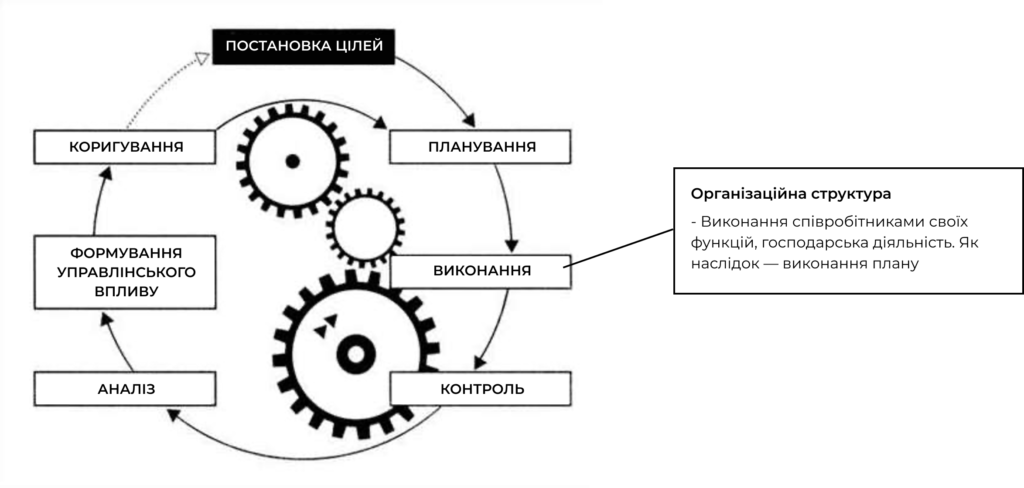Before we move on to discuss this topic and answer questions that are often not formalized in the minds of financial officers and executives, let's first define some fundamental concepts that will inform our understanding.
Any company needs management to achieve its goals, and therefore a mechanism that would ensure the link between setting goals and their fulfillment. This link is realized through various structures.
Structure - is a set of connections between parts of a whole.

In general, in order to manage something, you first need to structure the elements of that "something" and combine them into a system. After all, how can you manage chaos?
Strategy. This is a bit more complicated, because today there is no common understanding of what a strategy is. Conceptually speaking, it is the way a company operates, the methods it uses to achieve its goals.
In the course of a company's operations, its employees perform various functions that depend on the type of business the company is in. Some employees are responsible for procurement, others for sales, some are responsible for the timely submission of financial statements, and some ensure security. But everyone works to achieve the goal. The performance of such functions leads to the implementation of the company's Strategy.
On the other hand, activities need to be managed so that they do not become chaotic.
Accordingly, all functions can be divided into business functions (which depend on the company's activities) and management functions (which ensure the performance of business functions).
Thus, an effective organizational structure should ensure that two types of functions are performed.
| Business functions | Management functions |
| Procurement of raw materials | Setting goals |
| Production output | Normalization |
| Product packaging | Planning |
| Sales of products | Motivation. |
| Labor protection | Control |
| Preparation of reports | Coordination |
Everything we have talked about so far - strategies, functions, criteria - are abstract concepts. How can they be managed and put into action?
It is for the practical application of these principles that companies develop organizational units.
Orglanka - is a rectangle in the diagram called "Organizational Structure". It combines certain functions to be performed by employees assigned to this unit. It is a tool for implementing the strategy through executives.
The hierarchical structure of the divisions is organizational structure.
To formalize it, a regulatory document, the Regulation on the Organizational Structure, is developed and approved.
This document displays the hierarchy of departments in a schematic manner, helps new employees quickly find their place in the company, and often serves as an arbitration function in disputes over the distribution of responsibilities.
The organizational structure answers two key questions:
1. Who is responsible for what (functionally)?
2. Who reports to whom and how?
The impact of organizational structure on management efficiency
The organizational structure directly affects the performance of employees and, consequently, the effectiveness of management. It finds its design in the classic cycle of the management system.
Since the concept of organizational structure directly affects the performance of employees and, consequently, the effectiveness of management, let's recall the classic cycle of the management system and see how the organizational structure finds its design in this process.

As you can see from the diagram, the organizational structure is nothing more than a tool for effective management of the company's activities and directly takes its place in the management process.
It is also worth noting that the implementation of budget management begins with the development of an organizational structure, as it will be the basis for the creation of Financial Responsibility Centers.
Types of organizational structures
Depending on the distribution of functions between organizational units and their grouping, it is customary to classify organizational structures by type. Historically, three types have been most commonly used: linear (functional), divisional, and matrix.
Linear (functional) structure - based on the distribution of all organizational units by function. This means that this type of organizational structure is best suited to performing functions.
But herein lies the main drawback: there are those responsible for performing functions, but no one responsible for the final result. Responsibility for it arises only at the highest level (director). This type of organizational structure is the most common and is usually used in small companies.
Divisional structure - In the divisional structure, the important criterion is the allocation of divisions by product, and the function is used only as a grouping criterion for divisions that perform common functions for the entire enterprise. This type of structure allows you to focus primarily on the result of activities, and the performance of functions is of secondary importance.
Matrix structure - This type of structure can often be seen in project-based companies. The idea is that a certain institute of managers is created who are responsible for a specific project or work, and they engage specialists from other departments to solve their tasks. In such a structure, employees find themselves in a double chain of command: on the one hand, they are subordinate to their functional manager, and on the other hand, to the project manager. This is the main problem with this structure - double reporting. To mitigate such contradictions, it is necessary to carefully define the responsibilities of those in dual reporting lines.
Basic principles of organizational structure formation:
Each organdy, regardless of type, is formed according to certain principles, namely:
1. Functional principle - The organization of the org chart depends on the functions it is supposed to perform, for example: sales department, purchasing department, etc.
2. The product principle - is determined by the type of final product produced by the company, for example: Product A, Work B, Service C.
3. Technological principle - A link is identified based on the stage of production in the product chain, for example: Workshop No. 1, Workshop No. 2, Packaging workshop, etc.
4. Territorial principle - defines the geographical location or territory covered by the org chart, for example: Kyiv branch, Dnipro branch, Lviv branch.
5. Non-order principle - arises when a new order or project is placed. Such a link does not have a static position and ceases to exist at the moment of work performance. It is most often used in the matrix type of organization.
One company often uses a combination of the above principles, and in some cases all of them may be applied.
Stages of designing an organizational structure
1. Formalization of all business and management functions
At this stage, you need to make a detailed list of all business and management functions, organized by economic nature.
2. Formalization of organizational titles
As in the previous step, the column contains all organizational units that have been previously structured by the level of authority (from managerial to subordinate).
3. Organize.
The essence of organizational charting is to map functions to org charts. To do this, a table is created where the organizational structure is located vertically and the functions are located horizontally. A mark is placed at the intersection of the function and the unit responsible for its performance. Such an analysis also helps to avoid duplication of the same function by different units, which contradicts the management concept.
4. Type of structure
The type of organizational structure is chosen depending on the type of activity and business. It can be one or a combination of different types. In any case, it should describe the way the company's strategy is implemented as accurately as possible.
5. Writing regulations
The final stage is the preparation of regulatory documents: job descriptions, organizational structure, and other documents related to this process. The head of the company approves them with his or her signature, and employees must comply with them flawlessly.
Restructuring
In today's environment, companies operate in a dynamic environment, so the organizational structure may become outdated and irrelevant. New divisions may appear or new businesses may open. In addition, the strategy itself may change. For example, a company may grow to the point where the domestic market is no longer sufficient and it will need to enter the international market. In such circumstances, the strategy should be revised to meet the new standards.
In this regard, when developing an organizational structure, it is necessary to build in a certain amount of flexibility. It should be easily scalable and adaptable to any changes.
In our work, when automating management accounting, we also often deal with the organizational structure, as we develop the structure of the financial responsibility centers (FRCs) on its basis. I have to say that the quality and attitude of managers to the structure of departments often leaves much to be desired. Often, when you ask the question: "Do you have a developed organizational structure in your company?" - everyone, of course, says that they do. But in reality, it's either a long outdated 1C directory of departments or an Excel file where the company's departments have a certain structure, but it turns out that it's no longer relevant, and here you need to add a new business, etc. There is often no one responsible for updating it, and this, unfortunately, indirectly indicates the culture of domestic financial management.
